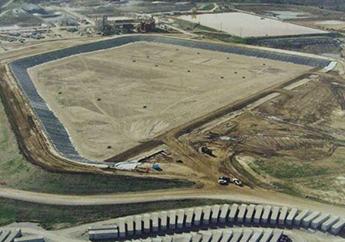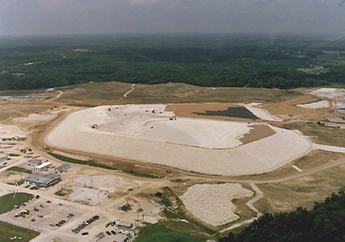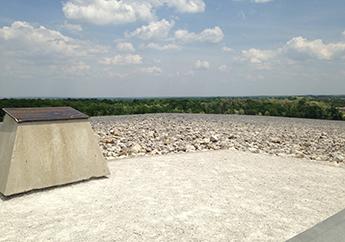The Problem
DOE's Weldon Spring Site consisted of two distinct locations, the chemical plant area and the quarry. The chemical plant was located on State Route 94, approximately two miles southwest of U.S. Route 40/61. This 217-acre site was the former location of a uranium feed materials plant, raffinate pit storage areas and explosives production. The quarry was located approximately four miles southwest of the chemical plant. The nine-acre limestone quarry was once used as a limestone gravel supply for operations at the site. Previous operations at the site resulted in chemical and radiological contaminants in soil and groundwater at the site.
Contaminants of Concern
Chemical contaminants included antimony, arsenic, cadmium, calcium hydroxide, chromium, ethylene glycol, friable and non-friable asbestos-containing material, heavy metals, hydrofluoric acid, magnesium, magnesium fluoride, manganese, mercury, molybdenum, nickel, nitrates, nitric acid, nitroaromatics, perchloric acid, polychlorinated biphenyls (PCBs), polyaromatic hydrocarbons, potassium hydroxide, selenium, sodium hydroxide, sulfates, tetrachloroethylene, tributyl phosphate and zinc. Radiological contaminants identified at the site were radium, thorium and uranium.
What’s Been Done
Active remediation, or cleanup, of the Weldon Spring Site was conducted under CERCLA and as part of DOE’s Environmental Restoration and Waste Management Program. Cleanup of the quarry included bulk waste removal, residual waste removal and land use controls restricting use of groundwater in the area and limiting use of the quarry to recreational purposes. The chemical plant area activities consisted of demolishing buildings, raffinate pit removal, placing waste into a 41-acre on-site engineered disposal cell and site restoration. One hundred and seventy acres of restored prairie land surrounds the disposal cell.
What’s Left
Active cleanup at the site is complete. The remedies for the Weldon Spring Chemical Plant, Quarry Bulk Waste and Quarry Residuals are protective of human health and the environment. The Groundwater operable unit remedy currently protects human health and the environment. Exposure pathways that could result in unacceptable risks are being controlled and institutional controls are in place and are effective. However, for the Groundwater operable unit remedy to be protective long-term, evaluating the unweathered unit must be performed to determine the need for additional monitoring wells and to assess alternative remedies in order to return groundwater to its beneficial use within a reasonable timeframe.
Areas that still have contamination, such as the groundwater, are being monitored as part of the selected remedy for the site. The quarry continues to be monitored to ensure protection of human health and the environment. The most recent five-year review report, evaluates the protectiveness of the entire site remedy for the long-term. The report concluded that the site is currently protective of human health and the environment, but identified two issues that may affect long-term protectiveness of the remedy at the site. DOE, in coordination with the Department of Natural Resources and EPA, is working to address these issues before completing the next five-year review.
Looking to the Future
The Weldon Spring Site Interpretive Center and administrative office space opened to visitors in April 2022. The new facility has updated exhibits, an auditorium and four student classrooms for educational purposes.
Site Description
From 1941 to 1945, as part of the World War II defense effort, the U.S. Army produced explosives at the Weldon Spring Ordnance Works, a separate facility located near Weldon Spring, not far from St. Louis. In 1955, the Army transferred 217 acres to the Atomic Energy Commission (AEC) for constructing the Weldon Spring Uranium Feed Materials Plant. The plant was located on State Route 94, approximately two miles southwest of U.S. Route 40/61. From 1957 to 1966, the feed materials plant tested and then processed some of the uranium ore concentrates and a small amount of thorium. The uranium ore refining process created sludge (raffinate), which was stored in four large, clay-lined, open-air lagoons called raffinate pits.
In 1958, the AEC acquired the title to the Weldon Spring Quarry from the Army. The quarry was located about four miles southwest of the feed materials plant. The Army used this nine-acre limestone quarry to extract limestone aggregate as a limestone gravel for use in constructing the Weldon Spring Ordnance Works. Later, the Army used the quarry pit to burn wastes from its explosives manufacturing operations and for disposing other wastes, including rubble contaminated with trinitrotoluene (TNT). From 1963 to 1969, the AEC disposed of uranium and thorium residues in the quarry. Material placed in the quarry during this time included building rubble containing uranium and radium, and soils from demolishing a uranium ore processing facility in St. Louis. Other radioactive materials in the quarry included drummed wastes, uncontained wastes and contaminated pieces of manufacturing equipment.
In 1967, the AEC returned the site to the Army for use as an herbicide production plant, otherwise known as the Weldon Spring Chemical Plant. In 1968, the Army started removing equipment and decontaminating several buildings; however, the herbicide project was canceled in 1969 before any process equipment was installed. The Army retained responsibility for the land and facilities of the chemical plant; the raffinate pits were transferred back to the AEC. The AEC was abolished in 1974. The Weldon Spring Site was placed in caretaker status, meaning no production or activity took place from 1981 through 1985, when custody was transferred from the Army to DOE. Surrounding properties that were historically part of this site have since been transferred to other owners, such as:
- Missouri Department of Conservation (August A. Busch Memorial Conservation Area)
- Missouri Department of Natural Resources (Katy Trail State Park)
- Missouri Department of Transportation
The Problem
Operation of the original explosives plant and the chemical plant resulted in contamination of the soil, groundwater and springs around the site. Wastes in the raffinate pits at the site resulted in chemical and radiological contaminants in soil and groundwater at the site. Chemical contaminants included antimony, arsenic, cadmium, calcium hydroxide, chromium, ethylene glycol, friable and non-friable asbestos-containing material, heavy metals, hydrofluoric acid, magnesium, magnesium fluoride, manganese, mercury, molybdenum, nickel, nitrates, nitric acid, nitroaromatics, perchloric acid, polychlorinated biphenyls (PCBs), polyaromatic hydrocarbons, potassium hydroxide, selenium, sodium hydroxide, sulfates, tetrachloroethylene, tributyl phosphate and zinc. Radiological contaminants identified at the site were radium, thorium and uranium.
Environmental Restoration
In 1985, DOE proposed designating control and decontaminating the chemical plant, raffinate pits and quarry as a major project, originally known as the Weldon Spring Site Remedial Action Project. Cleanup of the site was conducted under CERCLA, as part of DOE’s Environmental Restoration and Waste Management Program. This project was executed in two distinct locations, the Chemical Plant area and the Quarry. The quarry was placed on the Superfund National Priorities List (NPL) in July 1987. The chemical plant and raffinate pits were added to the NPL in March 1989.
Operable units are separate activities undertaken as part of a Superfund site cleanup. During project operations, there were four operable units: Quarry Bulk Waste, Chemical Plant, Groundwater and Quarry Residual. Remediation, or cleanup, of the quarry included bulk waste removal, residual waste removal and surface restoration of the area. Cleanup of the chemical plant area included demolishing buildings, raffinate pit removal, placing waste into an on-site engineered disposal cell and site restoration.
Two water treatment plants were built on-site to treat contaminated water. The Quarry Water Treatment Plant treated contaminated water from the quarry pit. The Site Water Treatment Plant was built to treat contaminated water that came in contact with the waste sludge in the raffinate pits. The water was treated to meet standards established by the Department of Natural Resources through the National Pollutant Discharge Elimination System guidelines. After testing by DOE, the Department of Natural Resources and St. Charles County laboratories, the treated water was discharged via a pipeline to the Missouri River. The Site Water Treatment Plant was taken offline and dismantled in 2000. The Quarry Water Treatment Plant was dismantled upon completing the Quarry Bulk Waste operable unit.
A major component of the remediation process at this site is the waste disposal cell. The disposal cell is a 41-acre area with layers of clay and plastic lining used to contain the waste placed inside it. From 1993 to 1995, bulk waste was removed from the quarry under the quarry bulk waste record of decision. The bulk material was transferred from the quarry to the disposal cell via a haul road that was constructed along an old rail-spur to prevent the material from being transported down public roads. Contaminated materials from the Site Water Treatment Plant, along with sludge from the bottom of the raffinate pits, were solidified into a cement-like grout in the Chemical Stabilization and Solidification Plant. The grout was then pumped to the disposal cell. Wastes from the chemical plant, as well as the chemical plant building demolition debris, were also placed in the disposal cell. The disposal cell was capped and construction was complete Oct. 23, 2001, with a finished height of 75 feet. A viewing platform was built on top of the disposal cell, which offers a panoramic view of St. Charles County and the surrounding Howell Prairie.
What’s Left
Remediation of soils and contaminated debris is complete. Waste management and groundwater monitoring continues at the site under long-term stewardship. Any water or condensation that remains inside the disposal cell is captured in a leachate collection system at the bottom of the cell. The water is then treated before being transported to the wastewater treatment plant. The Groundwater operable unit focuses on current groundwater remediation efforts at the Chemical Plant site. The Quarry Residual operable unit focuses on monitoring the groundwater to confirm the success of waste removal at the quarry. The Groundwater operable unit and the Quarry Residual operable unit are currently in a long-term monitoring phase to support the chosen remedy of monitored natural attenuation of contamination in the groundwater. Natural attenuation involves a variety of physical, chemical or biological in-place processes that, under favorable conditions, act without human intervention to reduce the mass, toxicity, mobility, volume or concentration of contaminants in groundwater.
The most recent five-year review report, the Weldon Spring Site: Sixth Five-Year Review, September 2021, evaluates the continuing effectiveness of the remedy at the site. This review found the site to be protective of human health and the environment currently; however, the long-term protectiveness of the remedy cannot be determined at this time. The Department of Natural Resources and EPA raised concerns with the performance of the groundwater attenuation and requested additional investigation to ensure the groundwater will be returned to beneficial use within a reasonable timeframe. These concerns were recognized in the most recent five-year review as two issues:
- Issue 1: The current monitoring well network may not be adequate to meet monitored natural attenuation remedy objectives.
- Issue 2: The remedy is not projected to return groundwater to its beneficial use within a reasonable timeframe.
Since the review was completed, DOE established a working group to evaluate the groundwater monitoring network and establish an implementation plan as they committed to in the five-year review report. The National Lab Network working group completed a recommendations report in May 2022, with several actionable recommendations to address the data needs to resolve the review issues. DOE is implementing those recommendations in a phased-approach, in coordination with Department of Natural Resources and EPA oversight.
Looking to the Future
The DOE maintains engineered and institutional controls at the Weldon Spring Site that protect human health and the environment. These controls include a combination of activities, such as surveillance activities, record-keeping activities, inspections, groundwater monitoring, cap repair, building maintenance, barriers and contained structures, access control and posting signs. The Department of Natural Resources provides oversight of these activities to make sure the site remains in regulatory compliance.
The Weldon Spring Site Interpretive Center is located next to the disposal cell. The interpretive center provides educational programs, tours, research opportunities and meeting rooms for public use. The surrounding gardens, prairie, trails and disposal cell viewing platform are open to the public to explore. For additional site information, including key documents, site history fact sheet, site brochure, site mapping and monitoring and an online virtual tour of the interpretive center, visit DOE’s Weldon Spring Site webpage.




